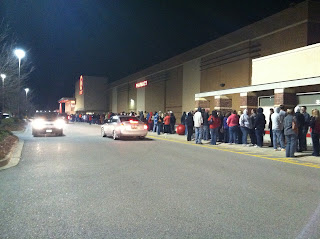Let’s hope it is your
competitor, rather than you, that has made these strategic choices that can limit
sales growth in 2012
1. Don’t
seek fresh consumer insights—you
know a lot about your consumer already.
Why waste money getting fresh insights when consumer purchase behavior
has changed in most categories in the last couple years. Maybe the impact of the economy, ecommerce,
social media, smartphones, etc. have not really changed the way your consumers
think and shop.
2. Don’t
update your website—Websites
cost money to update. Your current online
brochure of a website should be good enough for another year. So your competitors have interactive websites
with regular fresh content and aggressively sell their products through their
website and/or multiple web partners.
You do not need to worry about integrating fresh content, social media
or ecommerce. You haven’t seen any proof
that your website sells product. Why
invest more?
3. Don’t
go mobile—Sure a
lot of people have smartphones. But they
mostly seem to be used for email, texting or checking Facebook. You do not need to spend money this year
making sure consumers can access your website or buy your product on a
smartphone. So what that 38% of
consumers have made at least one purchase on their smartphone…that does not affect
your products.
4. Don’t
worry about SEO—why
spend money optimizing your search engine performance. If you search your company’s name they can
find you—even if you have to scroll down to find your listing. You do not need to worry about any other kind
of category search terms. It does not
matter that you come up on page 3 of a Google search and over 90% of consumers
click through the listings on just the first page. If someone really wants to find you, they
will be willing to do the work rather than choose your competitor who is easier
to find.
5. Extend
your advertising another year—Consumers
loved your advertising when it launched.
You saw a nice sales bump. So it
makes sense to continue to run that same great advertising for another year or
three. It does not matter that consumers
thought your ad was funny at first, but now the humor is stale—or that your
message has less impact in light of your competitor’s new product and ads. New advertising is expensive, so let’s
stretch the current campaign for one more year.
6. Assume
your packaging is good enough—At
least you do not need to worry about updating your packaging communication. You tend to update your packaging couple
years or when you have a new brand manager.
There is no need to freshen up your communication to educate shoppers or
make sure your packaging is more engaging than your competitor.
7. Go
with the same shopper marketing strategy this year—your promotions and in store
communication worked well last year. You
are up against those sales numbers again this year. It is safe to assume you can get the same
results or better from repeating last year’s promotions and in store
communication. There is no need to engage
your shopper in new ways this year.
8. Don’t
expect your competitors to innovate—in
this economy, it is best to cut back and survive the downturn rather than risk
investing in the future. Everyone is
affected, so your competitor will not innovate if you do not. After all, you are the category leader. When the market starts to rebound, you can
begin to reinvest in the future. Your
competitor is sure to follow your lead.
9. Sell
only on price—with this
economy, why give your consumers a reason to buy other than price. A good enough product at a good enough price may
be a good enough strategy to reach a good enough sales goal.
10. Cut your marketing budget (again)—your competitors have been limiting
their marketing spend so you can save money too. After all, marketing spending is just a cost,
not a strategic investment. Who wants to
gain share in a down market by outmarketing their competition. And, if you time your budget cuts just right,
you can reduce your spending and your sales.
These are great ways
to avoid growing a business this year.
If some of these are in your company’s 2012 plan, consider another
approach—but only if you want to accelerate your sales in the New Year.
GrowthSpring Group is a market research, marketing strategy and innovation firm focused on accelerating your sales and profit growth. We help you identify new business growth insights & opportunities and execute winning strategies & plans. www.GrowthSpringGroup.com











